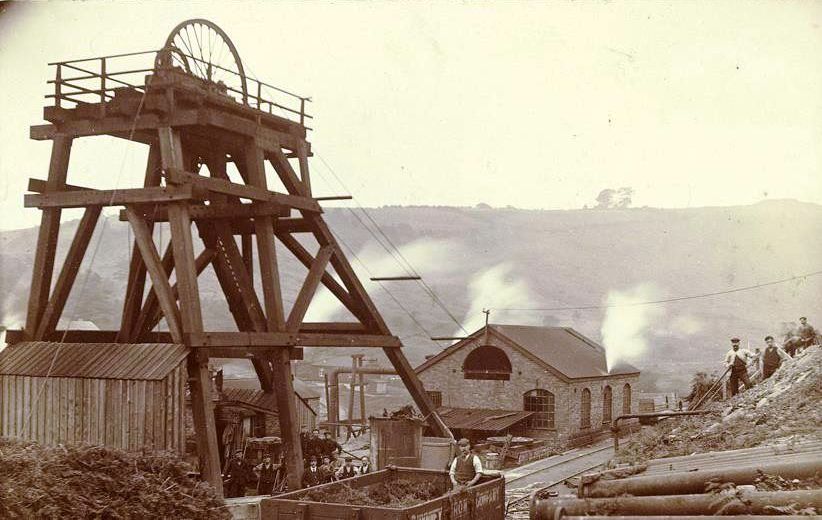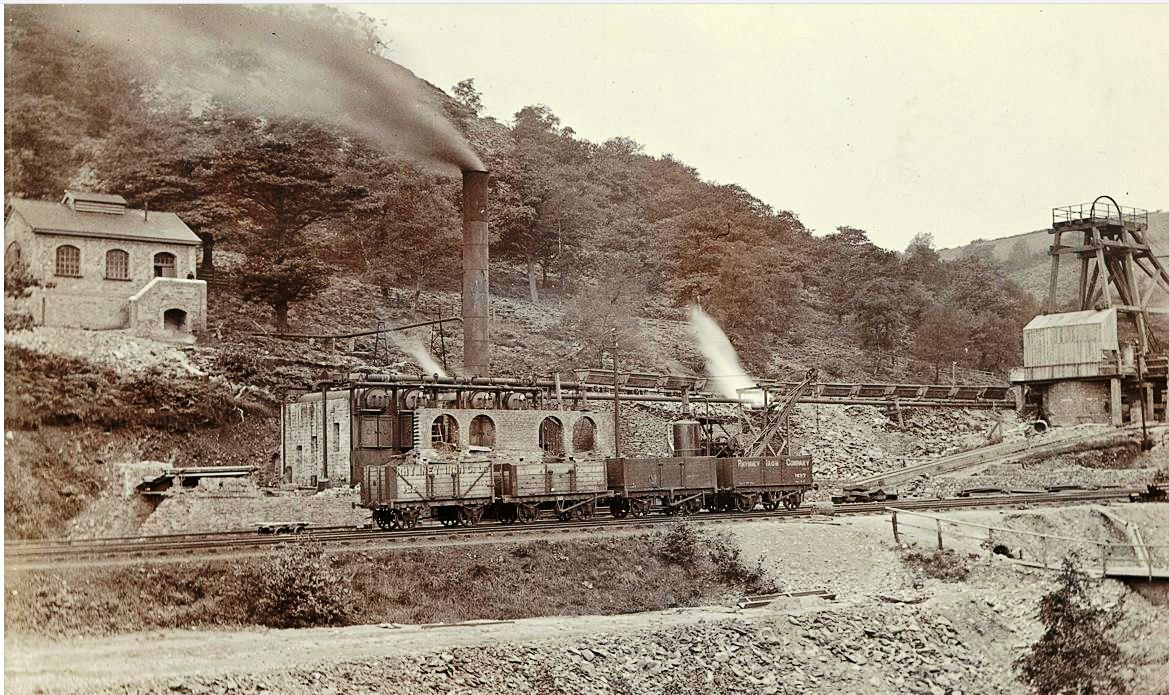Bargoed (SO 1353 0064)
The sinking of the 20 foot diameter shaft commenced in 1902 and was completed in 1906 at a depth of 720 yards and a cost of £183,723 by the Rhymney Iron Company. The sinking of the colliery’s sister pit, Pengarreg, commenced at the same time. Groesfaen Colliery was connected to the Darran Colliery which was 850 yards to the north and to Gilfach Colliery which was 3,270 yards to the south.
In 1906 a Walker type ventilating fan was installed that was 25 feet in diameter and 8 feet wide.
By 1908 the colliery employed 173 men underground and 99 men on the surface. It produced steam coals from the Middle and Lower Coal Measures and was served by the Rhymney Railway.
In 1935 Groesfaen Colliery employed 200 men on the surface and 1,080 men underground with the manager being D. Williams (he was also the manager in 1927). In 1938 the manager was E. Morgan and in 1943/5 it was I.G. Thomas.
By 1938 the employment had increased to 694 men working underground in the Seven-Feet, Red and Upper Four-Feet seams and 208 men working at the surface of the pit.
On the Sunday nightshift, the 30th of July 1939 lightning knocked all the power off to this colliery trapping the men underground for six hours. This colliery had its own coal preparation plant (washery).
In 1955 out of a total manpower of 1,029 men at this colliery, 566 of them worked at the coalfaces. The coalface figure gradually dropped during the late 1950s to 550 men in 1956, 501 men in 1957 and 467 men in 1958. In 1961 out of a total manpower of 841 men, 363 of them worked at the coalfaces, with the Y1 Training coalface having the capacity to train forty men or boys at a time. In 1961 Groesfaen Colliery was in the No.5 Area’s, No.1 Group along with Elliot and Ogilvie collieries. The total manpower for this Group was 3,643 men, while total coal production for that year was 814,099 tons. The Group Manager was J.H. Jenkins, while the Area Manager was G. Tomkins.
In May 1967 this colliery employed 720 men, with 535 of them working underground in the Rhas Las, Six-Feet, Red, Seven-Feet and Lower-Four-Feet seams. The L7 coalface was just opened in the Lower-Four-Feet seam which had a section of 44 inches with both a clay floor and roof. It was 620 yards underground and 530 feet long and cut with a plough and increased the pits productivity from 15.2 hundredweights per man shift to 23.4 hundredweights per man shift but even this was not enough. Groesfaen Colliery was closed by the National Coal Board on the 22nd of November 1968 due to it being uneconomic.
Power loading equipment was transferred to Cwmtillery Colliery and 350 of the men transferred to Ogilvie, Britannia, Bargoed, Markham, Bedwas, Deep Navigation and Trelewis Drift. Eighty men retired early and 60 men were retained for salvaging.
Average seam sections were:
- The Upper-Six-Feet seam was at a depth of 1,703 feet, and was; coal 16”, dirt 2”, coal 7”, dirt 25”, coal 4”, dirt 36”, coal 31”.
- The Lower-Six-Feet seam was at a depth of 1,756 feet, and was; coal 5”, dirt 9”, coal 2”, dirt 14”, coal 25”, dirt 10”, coal 8”.
- The Lower-Nine-Feet seam was at a depth of 1,836 feet and was; coal 3”, dirt 8”, coal 19”, dirt 3”, and coal 21”.
- The Yard seam was at a depth of 1,951 feet and was; coal 2”, dirt 20”, coal 14”.
- The Seven-Feet seam was at a depth of 1,971 feet and was; coal 12”, dirt 5”, coal 13”. The Five-Feet/Gellideg seam was at a depth of 2,035 feet and was; coal 16”, dirt 7”, coal 8”, dirt 48”, and coal 29”.
Some of the fatalities at this pit:
- 28/5/1910, Albert Trigg, aged 24, fall of the roof
- 15/7/1910, John Llewellyn, aged 25, collier, fall of roof
- 16/1/1912, John Cooper, aged 20, collier, fall of roof
- 30/5/1913, Joseph Bufton, aged 18, collier, killed by trams
- 4/7/1913, William Bromley, aged 27 years, collier, fall of roof
- 20/1/1914, John Jones, surface foreman, fell down the shaft
- 30/1/1914, William Donovan, aged 22, labourer, killed by trams
- 1/4/1914, James Dunn, aged 42, assistant repairer, fall of roof
- 1/10/1914, Evan Roberts, aged 47, assistant timberman, fall of roof
- 5/11/1928, Edward Thomas Price, aged 61, labourer, killed by trams
As well as the fatalities, there were many serious accidents in this dangerous job, below are some from 1925:
- 3rd March, Gwilym Evans, aged 45 years and a labourer, Struck by door of tram while lowering empty.
- 24th March, David Feor, aged 54 years and a fanman, was run over by trams.
- 27th March, David Cheeke, aged 33 years and a collier, under a roof fall.
- 21st May, Joseph Evans, aged 53 years, repairer, roof fall.
- 23rd June, William Williams, aged 61 years and a repairer, tramming a full tub of rubbish when tram overtook him an crushed him.
- 15th of July, William Pritchard, aged 31 years and a collier, roof fall.
- 1st August, David Harris, aged 43 years and a collier, fall of roof.
- 15th of December, Idris Harris, aged 21 years and a haulage driver, was examining haulage engine foot slipped between the cylinders and was crushed.
Some statistics:
- 1903: Manpower: 107
- 1905: Manpower: 110
- 1907: Manpower: 131
- 1908: Manpower: 272.
- 1909: Manpower: 272.
- 1910: Manpower: 674
- 1911: Manpower: 538
- 1912: Manpower: 1,204
- 1913: Manpower: 1,095.
- 1915/6: Manpower: 1,248.
- 1918: Manpower: 1,149.
- 1919: Manpower: 995.
- 1920: Manpower: 995.
- 1922: Manpower: 400
- 1923: Manpower: 1,061
- 1924: Manpower: 1,100
- 1925/6: Manpower: 1,150
- 1927: Manpower: 1,379.
- 1928: Manpower: 1,449
- 1929: Manpower: 1,414
- 1930: Manpower: 1,536.
- 1931: Manpower: 1,501.
- 1932: Manpower: 1,596.
- 1933: Manpower: 1,151.
- 1934: Manpower: 1,179
- 1935: Manpower: 1,280. Output: 430,000 tons.
- 1937: Manpower: 1,420
- 1938: Manpower: 1,281.
- 1940: Manpower: 1,189.
- 1941: Manpower: 1,145.
- 1942: Manpower: 1,027.
- 1944: Manpower: 942.
- 1945: Manpower: 992
- 1947: Manpower: 934.
- 1948: Manpower: 1,140. Output: 318,000 tons.
- 1949: Manpower: 1,039. Output: 318,376 tons.
- 1950: Manpower: 1,045.
- 1953: Manpower: 1,033. Output: 355,000 tons.
- 1954: Manpower: 1,067. Output: 234,000 tons.
- 1955 Manpower: 1,029. Output: 257,615 tons.
- 1956: Manpower: 1,051. Output: 238,830 tons.
- 1957: Manpower: 1,021. Output: 220,139 tons.
- 1958: Manpower: 990. Output: 210,042 tons.
- 1960: Manpower: 843. Output: 171,152 tons.
- 1961: Manpower: 841. Output: 149,852 tons.
- 1965: Manpower: 861.
- 1968: Manpower: 731.
This information has been provided by Ray Lawrence, from books he has written, which contain much more information, including many photographs, maps and plans. Please contact him at welshminingbooks@gmail.com for availability.
Return to previous page


